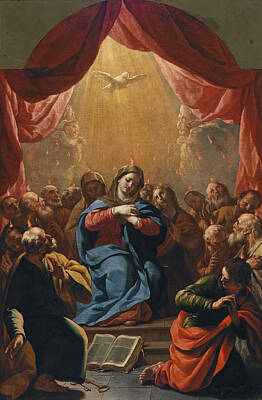Antonio Palomino
The Archangel Michael Defeating The Devil
The Infant Saint John The Baptist
Acislo Antonio Palomino de Castro y Velasco (1653 – 13 April 1726) was a Spanish painter of the Baroque period, and a writer on art, author of El Museo pictórico y escala óptica, which contains a large amount of important biographical material on Spanish artists.
Life
Antonio Palomino was born to a respectable family at Bujalance, near Córdoba in 1653. He studied philosophy, theology and law at Córdoba, and had lessons in painting from Juan de Valdés Leal, who visited there in 1672, and afterwards from Juan de Alfaro y Gamez in 1675.[1]
After taking minor orders Palomino moved to Madrid in 1678, where he associated with Alfaro, Claudio Coello, and Juan Carreño de Miranda, and executed some indifferent frescoes. He soon afterwards married a lady of rank, and, having been appointed alcalde of the mesta, was himself ennobled; in 1688 he was appointed painter to King Charles II. The artist visited Valencia in 1697, and remained there for three or four years, again devoting himself to fresco painting, including the ceilings of the church of the Santos Juanes. Between 1705 and 1715 he spent considerable amounts of time in Salamanca, Granada and Córdoba; in the latter year the first volume of his work on art, El Museo pictórico y escala óptica, appeared in Madrid. He painted the ceiling fresco in the dome of the sacristy of the Cartuja de Granada. After the death of his wife in 1725 Palomino took priest's orders. He died on 13 August 1726.[1]
El Museo pictórico y escala óptica
Palomino's El Museo pictórico y escala óptica first appeared in 1715–24 in a three-volume folio edition. The first two parts, on the theory and practice of the art of painting, have had little influence. The third, subtitled El Parnaso español pintoresco laureado, contains a large amount of important biographical material relating to Spanish artists, which, despite its uneven style, has led to the author being called "the Spanish Vasari" . It was partially translated into English in 1739 as An account of the lives and works of the most eminent Spanish painters, sculptors and architects; an abridgment of the original (Las Vidas de los pintores y estatuarios españoles) was published in London in 1742, and appeared in a French translation in 1749. A German version was published at Dresden in 1781, and a reprint of the entire work at Madrid in 1797.[1] A modern English translation of the abridgment by Nina Ayala Mallory came out in 1987 from Cambridge University Press (ISBN 0-521-33474-8).
References
One or more of the preceding sentences incorporates text from a publication now in the public domain: Chisholm, Hugh, ed. (1911). "Palomino de Castro y Velasco, Acisclo Antonio". Encyclopædia Britannica. 20 (11th ed.). Cambridge University Press. p. 655.
----
Fine Art Prints | Greeting Cards | Phone Cases | Lifestyle | Face Masks | Men's , Women' Apparel | Home Decor | jigsaw puzzles | Notebooks | Tapestries | ...
----
Artist
A - B - C - D - E - F - G - H - I - J - K - L - M -
N - O - P - Q - R - S - T - U - V - W - X - Y - Z
Retrieved from "http://en.wikipedia.org/"
All text is available under the terms of the GNU Free Documentation License








